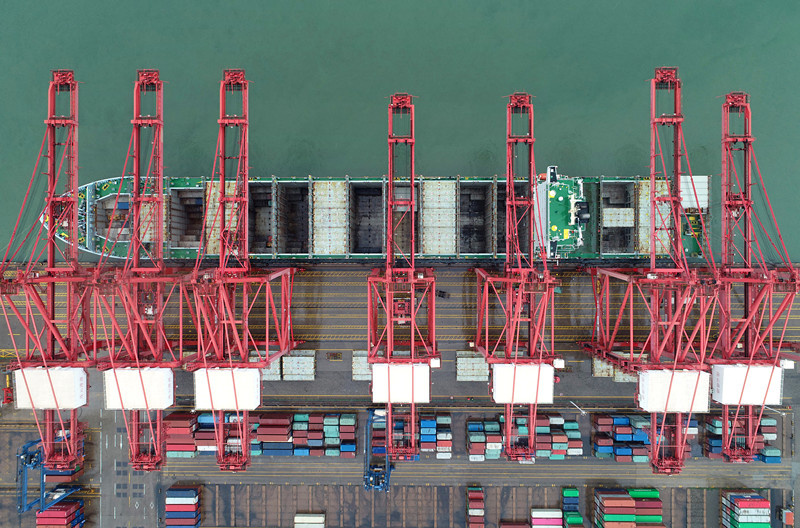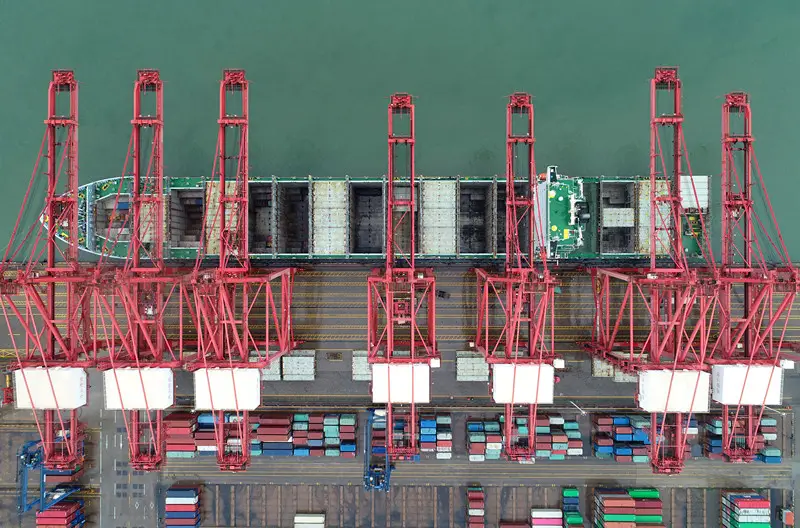By Du Haitao, People's Daily

An oceangoing freighter is being loaded with cargos at a container terminal of Lianyungang Port, east China's Jiangsu Province, Aug. 7, 2020. (Photo by Wang Jianmin/People's Daily Online)
China delivered remarkable foreign trade performance in the past year. According to the country's General Administration of Customs (GAC), China's total imports and exports expanded 1.9 percent year on year to 32.16 trillion yuan ($4.97 trillion), hitting a record high.
Exports rose 4 percent to 17.93 trillion yuan, while imports stood at 14.23 trillion yuan, down 0.7 percent, according to the GAC. Trade surplus reached 3.7 trillion yuan, rising 27.4 percent from a year ago.
China's foreign trade exceeded expectations and registered a historical high last year, when the country faced a grave and complex domestic and international landscape and a severe economic impact posed by COVID-19, said GAC spokesperson Li Kuiwen, adding that China was the only major economy to realize positive economic growth last year, which indicated its great resilience and comprehensive competitiveness.
From June 2020, China registered positive growth in foreign trade for seven consecutive months and hit a record high in total foreign trade volume and exports, which further consolidated China's role as the world's largest trader in goods. In 2020, ASEAN, European Union, the United States, Japan, and South Korea were China's largest five trading partners, and China's trade with countries along the Belt and Road reached 9.37 trillion yuan, up 1 percent.
Affected by the pandemic, international flights were suspended and significantly reduced last year, and the traditional shipping capacity plummeted. The GAC promptly issued ten measures to support the development of the China-Europe Railway Express, striving to ensure the stability of industrial and supply chains, Li, who's also the director of the GAC's Department of Statistics & Analysis, introduced.
According to him, China ran 12,400 China-Europe freight trains throughout the year and delivered nearly 1.14 million twenty-foot equivalent units, up by 50 percent and 56 percent year on year, respectively. The combined heavy container rate reached 98.4 percent.
Global trade dramatically shrank due to the pandemic last year, while China's huge domestic market showed a more prominent advantage in stabilizing imports. In 2020, China imported 7.3 percent more crude oil and 7 percent more metal ore. Besides, exports of traditionally competitive products maintained growth. In 2020, China's exports of electromechanical products increased by 6 percent to 10.66 trillion yuan, and exports of laptops, home appliances, and medical equipment went up by 20.4 percent, 24.2 percent, and 41.5 percent, respectively.
"Exports of anti-epidemic supplies provided strong support for the global combat against COVID-19," Li noted. China has been playing its part as the world's largest supplier of anti-epidemic materials by proactively carrying out international cooperation to fight against the COVID-19 pandemic, and making the utmost efforts to provide and export anti-epidemic materials to over 200 countries and regions.
From March to December 2020, customs authorities across China cleared major anti-epidemic supplies worth 438.5 billion yuan, including 224.2 billion masks with a value of 340 billion yuan, which is equivalent to providing nearly 40 face masks for every individual in the world outside of China. The country also exported 2.31 billion protective suits, 289 million pairs of goggles, 2.92 billion pairs of surgical gloves, 271,000 ventilators, 663,000 patient monitors and 119 million infrared thermometers.
According to statistics, China's cross-border e-commerce imports and exports in 2020 were 1.69 trillion yuan, an increase of 31.1 percent, and market procurement exports were up 25.2 percent, becoming an important stabilizer for foreign trade.
"The new development pattern, in which domestic and foreign markets reinforce each other, with the domestic market as the mainstay, is now taking shape in China at a higher speed. The country is also promoting a higher level of opening-up and developing new advantages in international cooperation and competition. Thus, I believe China is expected to maintain its foreign trade growth in 2021," Li remarked.
Exports rose 4 percent to 17.93 trillion yuan, while imports stood at 14.23 trillion yuan, down 0.7 percent, according to the GAC. Trade surplus reached 3.7 trillion yuan, rising 27.4 percent from a year ago.
China's foreign trade exceeded expectations and registered a historical high last year, when the country faced a grave and complex domestic and international landscape and a severe economic impact posed by COVID-19, said GAC spokesperson Li Kuiwen, adding that China was the only major economy to realize positive economic growth last year, which indicated its great resilience and comprehensive competitiveness.
From June 2020, China registered positive growth in foreign trade for seven consecutive months and hit a record high in total foreign trade volume and exports, which further consolidated China's role as the world's largest trader in goods. In 2020, ASEAN, European Union, the United States, Japan, and South Korea were China's largest five trading partners, and China's trade with countries along the Belt and Road reached 9.37 trillion yuan, up 1 percent.
Affected by the pandemic, international flights were suspended and significantly reduced last year, and the traditional shipping capacity plummeted. The GAC promptly issued ten measures to support the development of the China-Europe Railway Express, striving to ensure the stability of industrial and supply chains, Li, who's also the director of the GAC's Department of Statistics & Analysis, introduced.
According to him, China ran 12,400 China-Europe freight trains throughout the year and delivered nearly 1.14 million twenty-foot equivalent units, up by 50 percent and 56 percent year on year, respectively. The combined heavy container rate reached 98.4 percent.
Global trade dramatically shrank due to the pandemic last year, while China's huge domestic market showed a more prominent advantage in stabilizing imports. In 2020, China imported 7.3 percent more crude oil and 7 percent more metal ore. Besides, exports of traditionally competitive products maintained growth. In 2020, China's exports of electromechanical products increased by 6 percent to 10.66 trillion yuan, and exports of laptops, home appliances, and medical equipment went up by 20.4 percent, 24.2 percent, and 41.5 percent, respectively.
"Exports of anti-epidemic supplies provided strong support for the global combat against COVID-19," Li noted. China has been playing its part as the world's largest supplier of anti-epidemic materials by proactively carrying out international cooperation to fight against the COVID-19 pandemic, and making the utmost efforts to provide and export anti-epidemic materials to over 200 countries and regions.
From March to December 2020, customs authorities across China cleared major anti-epidemic supplies worth 438.5 billion yuan, including 224.2 billion masks with a value of 340 billion yuan, which is equivalent to providing nearly 40 face masks for every individual in the world outside of China. The country also exported 2.31 billion protective suits, 289 million pairs of goggles, 2.92 billion pairs of surgical gloves, 271,000 ventilators, 663,000 patient monitors and 119 million infrared thermometers.
According to statistics, China's cross-border e-commerce imports and exports in 2020 were 1.69 trillion yuan, an increase of 31.1 percent, and market procurement exports were up 25.2 percent, becoming an important stabilizer for foreign trade.
"The new development pattern, in which domestic and foreign markets reinforce each other, with the domestic market as the mainstay, is now taking shape in China at a higher speed. The country is also promoting a higher level of opening-up and developing new advantages in international cooperation and competition. Thus, I believe China is expected to maintain its foreign trade growth in 2021," Li remarked.
 Menu
Menu
 China achieves remarkable foreign trade progress in 2020
China achieves remarkable foreign trade progress in 2020
















